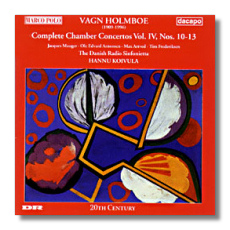
The Internet's Premier Classical Music Source
Related Links
- Latest Reviews
- More Reviews
-
By Composer
-
Collections
DVD & Blu-ray
Books
Concert Reviews
Articles/Interviews
Software
Audio
Search Amazon
Recommended Links
Site News
 CD Review
CD Review
Vagn Holmboe

Chamber Concertos #10-13
- Chamber Concerto #10 for Wood, Brass & Gut, Op. 40
- Chamber Concerto #11 for Trumpet, Op. 44
- Chamber Concerto #12 for Trombone, Op. 52
- Chamber Concerto #13 for Viola & Oboe, Op. 67
Danish Radio Sinfonietta/Hannu Koivula
Marco Polo (dacapo) 8.224087
Those already familiar with the music of Vagn Holmboe (1909-96), and especially with this series, of which this is Volume IV (the preceding volumes contain the first nine concertos), have a good idea of what to expect here. In this entry we have the final four concertos, the last three of which follow the previous pattern of featuring a solo instrument (or two). The Tenth (1945-46), specified for "wood, brass and gut" and orchestra, is the only one with no solo instrument in the spotlight. The Eleventh (1948) is for trumpet (played here by Ole Edvard Antonsen), the Twelfth (1950) for trombone (Jacques Mauger), and the Thirteenth (1955-56) for viola and oboe (Tim Frederiksen and Max Artved, respectively).
Holmboe's style here has a measure of typical Scandinavian influences, most notably that of Carl Nielsen. There are, however, echoes of Shostakovich, especially in the first movement of the Tenth. But Holmboe created his own rather distinct style, passing on his voice in varying degrees to compatriots Per Nørgard and Svend Nielsen, two major voices from the Danish musical scene of the latter half of the 20th century who still remain vital figures at the beginning of the new millennium.
It is probably no coincidence that the Tenth and Thirteenth Concertos are the longer ones – no coincidence, because they are instrumentally less limited in their range of expression, and have, at least to me, a bit more substance, more color, and a grander musical design. The other pair, both featuring brass instruments, are thematically appealing, to be sure, but are lighter and less variegated in mood. Depending on your sensibilities, though, you may actually favor the more muscular brass pair for their generally brighter worlds and infectious rhythms.
In any event, all four works are compelling, though I think I marginally favor the nine-movement (eight, actually, plus an introduction) Tenth Concerto over the others. This is a dramatic, gripping work that must encompass some feelings about the then recently-concluded war. There is a sense of darkness early on, and the last three movements are triumphant, seeming to affirm victory, celebrate life. Performances by the Danish Radio Sinfonietta under the alert baton of Hannu Koivula are quite convincing, shortchanging no aspect of Holmboe's deft scoring. Soloists throughout are also quite impressive, with trombonist Mauger and trumpeter Antonsen both sounding in fine form. The sound reproduction is vivid. To those with an interest in the byways of 20th-century music, this is a most worthwhile album.
Copyright © 2000, Robert Cummings


















